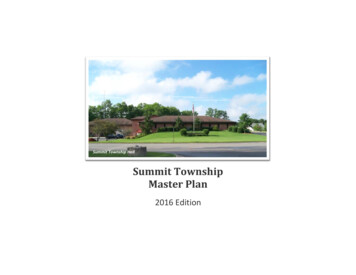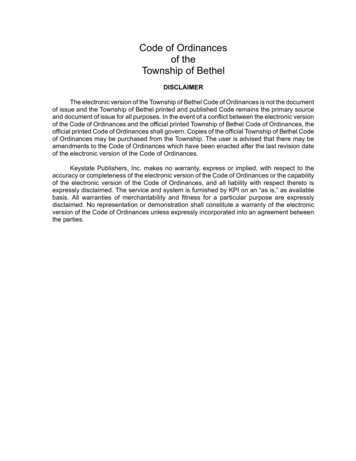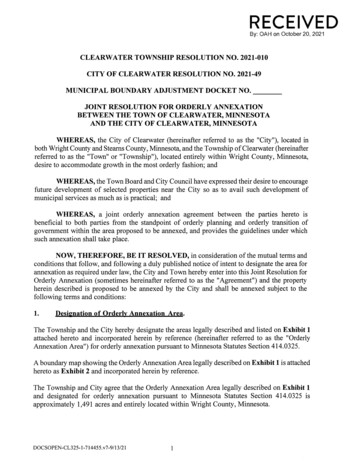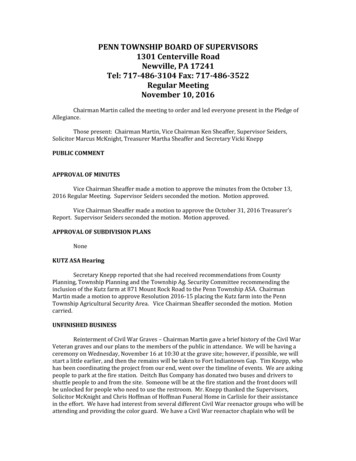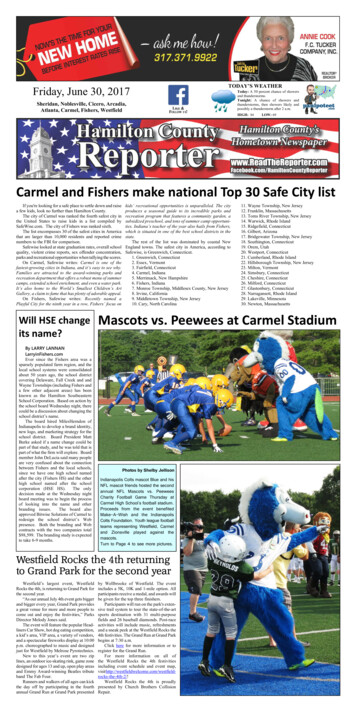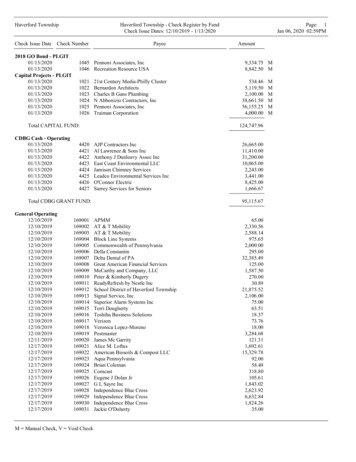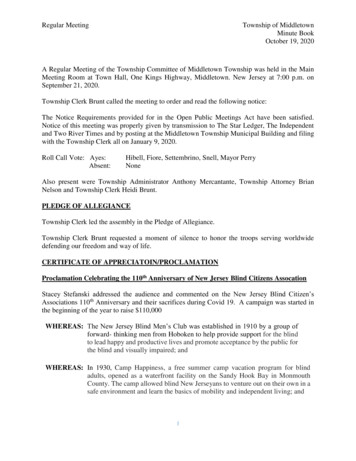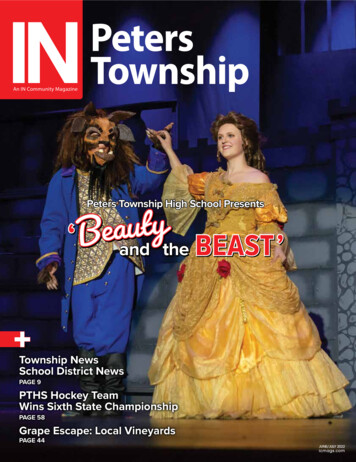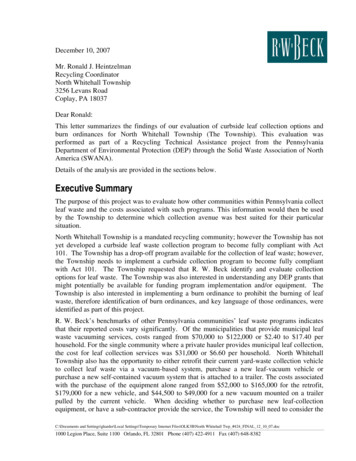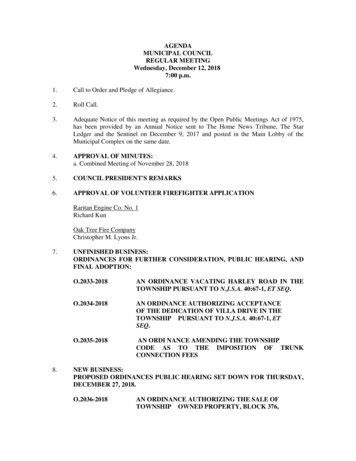
Transcription
Curriculum Implementation Plan2011-2014Franklin Township Public SchoolsTable of Contents1. Common Core Standards Initiativea. Backgroundb. Mission2. Curriculum Revision Timelinesa. New Jersey Department of Educationb. Franklin Township Public Schools3. District Curriculum Revision / Implementation Plan4. Rubicon Curricular Mapping System5. Curriculum Template6. District Curriculum Philosophy7. Curriculum Revision / Implementation Plan by Content Areaa. Revision / Implementation Plan Timelinesb. Curriculum Philosophyc. Units of Studyd. Rubicon Liaisonse. Curriculum Writing Teamsf.Professional Development1 Page
Common Core Standards InitiativeBackgroundIn June 2009, 46 states (including New Jersey), 2 territories and the District of Columbia, committed to developing a common core of state standards in EnglishLanguage Arts (ELA) and Mathematics for grades K-12. The purpose of this state-led initiative was to create a rigorous set of shared standards crafted to “definethe knowledge and skills students should have within their K-12 education careers so they graduate high school able to succeed in entry-level, credit-bearingacademic college courses and workforce training programs.”The Common Core Standards Initiative (CSSI) was coordinated by the National Governors Association Center for Best Practices (NGA Center) and the Council ofChief State School Officers (CCSSO) and developed in collaboration with teachers, school administrators, and experts, to provide a clear and consistentframework to prepare our children for college and the workforce. The standards are informed by the highest, most effective models from states across thecountry and countries around the world, and provide teachers and parents with a common understanding of what students are expected to learn. Consistentstandards will provide appropriate benchmarks for all students, regardless of where they live.The Common Core State Standards (CCSS) are designed to: align with college and work expectations; be clear, understandable and consistent; include rigorous content and application of knowledge through high-order skills; build upon strengths and lessons of current state standards; be informed by other top performing countries; and be grounded in research and evidence.MissionThe Common Core State Standards provide a consistent, clear understanding of what students are expected to learn, so teachers and parents know what theyneed to do to help them. The standards are designed to be robust and relevant to the real world, reflecting the knowledge and skills that our young people needfor success in college and careers. With American students fully prepared for the future, our communities will be best positioned to compete successfully in theglobal economy.2 Page
Curriculum Revision TimelinesIn response to the adoption of the Common Core Standards by the State of New Jersey, all New Jersey school districts are required to rewrite curriculum inEnglish Language Arts and Mathematics in alignment to the Common Core Standards and in alignment to the 2009 core curriculum content standards in all othercontent areas for implementation according to the timelines below.New Jersey Department of EducationRevised Core Curriculum Content AreaStandard Alignment K-12 English Language Arts MathematicsCommon Core StandardsCommon Core StandardsAdoption of RevisedStandardsJune 16, 2010June 16, 2010 2009 NJCCCS2009 NJCCCS2009 NJCCCSScienceVisual and Performing ArtsComprehensive Health and Physical EducationTechnologyst21 Century Life and CareersWorld LanguagesSocial StudiesGrade(s)June 17, 2009June 17, 2009K-12K-23-5 and High School6-8K-12K-12Implementation of RevisedCurriculaSeptember 2012September 2011September 2012September 2013September 2011September 2012September 9, 2009K-12September 2012Franklin Township Public SchoolsRevised Core Curriculum Content AreaStandardAlignment K-12Common CoreStandardsCommon CoreStandardsGrade(s)K-12NJDOE ImplementationTimelineSeptember 2012K-23-5September 2011September 20129-12September 20126-8September 2013FTPS Curriculum Development Science2009 NJCCCSK-12September 2011 Visual and Performing Arts Comprehensive Health and PhysicalEducation Technologyst 21 Century Life and Careers World Languages Social Studies2009 NJCCCSK-12September 2012Model UnitsK-12 CurriculaModel Units / K-2 CurriculaModel Units3-5 CurriculaModel Units9-12 CurriculaModel Units6-8 CurriculaSemesters 1 and 2Semesters 3 and 4K-12 Curricula2009 NJCCCSK-12September 2012K-12 Curricula English Language Arts MathematicsCompletion /Implementation TimelineAugust 2011September 2012September 2011August 2011September 2012August 2011September 2012August 2011September 2012September 2011February 2012September 2012September 20123 Page
Curriculum Writing PlanInstructional LeadershipThe department of Curriculum & Instruction will provide direct oversight for the revision and implementation of the 2011-2014 curriculum writing plan. Incollaboration, the Assistant Superintendent, content area directors, supervisors and coaches will create and implement the curriculum writing plan, providingtechnical assistance, instructional support and professional development to principals, assistant principals and the teaching staff.Supervisors and directors meet monthly to discuss and research best practices for curriculum design, create curriculum writing implementation plans anddevelop professional learning activities that will support curriculum implementation. Products from the 2010-2011 school year include: District Curriculum Philosophy Curriculum Philosophy by Content Area (developed in collaboration with teachers in each department) Curriculum Template Units of Study District In-Service / Professional Development Activities for 2011-2012 Curriculum Implementation Plan Curriculum Implementation Plans by Department Identification of teachers who will be assigned to design curriculum for specific units of study Identification of teachers who will be designated as the Rubicon liaison Curriculum Writing Calendars / Timelines Common Planning Groups Model Units Summer Curriculum Writing PilotGap AnalysisDuring the 2010-2011 school year, a gap analysis was conducted in all major content areas to identify the gap between the District’s current curriculum and the2009 NJCCCS / Common Core Standards. Conducting a gap analysis facilitated comprehensive opportunities for teachers to unpack and begin to explore the2009 NJCCCS / Common Core Standards. It also provided professional learning and opportunities for dialogue across content areas, grade spans and schools inthe areas of understanding rigor, grade level appropriateness of learning activities, modifications vs. watering down curriculum, vertical articulation and areasnot addressed in our curriculum.State of CurriculumPrior to the 2010-2011 school year, curriculum in Franklin Township was generally written over the summer by a small committee of teachers on a paid stipendupon completion of the curriculum work. A curriculum guide was presented to the Curriculum Committee / Board for adoption and then distributed to teachersin the grade / department for implementation. After reviewing the state of the district’s curriculum, the following findings were noted: Curriculum guides vs. curriculum were submitted to the Curriculum Committee / Board for approval Curricular components had not been defined Curriculum housed in binders vs. electronic data base Curriculum was written in small committee and distributed to teachers for implementation Inconsistent implementation of curriculum across district4 Page
Various types of curriculum implemented but not officially approved by Board (i.e. Readers / Writers workshop) or visa-versa, approved by Board but notimplementedVaried levels of rigor / grade level appropriatenessVaried time allotments for subject area application / curriculum coverageCurriculum Philosophy (See page, )The Department of Curriculum & Instruction believes that curriculum should be alive, dynamic, ongoing, and reflect what students should know and be able todo in the 21st century, as outlined by the 2009 NJCCCS and Common Core Standards. As such, it has developed a District Curriculum Philosophy that will guidethe development of district curriculum and defined how we will know, as a district, when we have accomplished our curricular goals.In accordance with our belief, beginning July 2011, curriculum writing will be an ongoing process that includes the collaboration of all directors, supervisors,coaches and teachers. The curriculum process will be guided by the District curriculum philosophy; be grounded in big ideas, essential questions, enduringunderstandings and differentiated instruction; and will be revised through multiple opportunities for vertical articulation and feedback across the district.Professional learning opportunities will be integrated into the curriculum writing process for a clear understanding of the 2009 NJCCCS and Common CoreStandards and the integration of appropriate levels of rigor and grade level appropriateness.Professional Learning (See attachment)Directors and supervisors will provide professional learning sessions for all summer curriculum writing teams in July 2011 and on September 2nd for curriculumwriting that will take place during the 2011-2012 school year. The professional development sessions addressing the curriculum components will be provided toteachers and staff prior to the commencement of any curriculum writing. Model units were developed for each content area in August 2011 by directors,supervisors and coaches to provide an anchor for the curriculum work that will take place throughout the year. The professional learning will include: District Curriculum Philosophyo Review / Discussiono Defining Common Language Curriculum Templateo Defining / Understanding curriculum template components (essential questions, enduring understandings, etc.)o Identifying big ideas in 2009 NJCCCS and Common Core Standards Model Unito Creating / Reviewing model units to understand how it supports all of the elements of the philosophy / common language / components Curriculum Writing Rubicon TrainingRubicon Curriculum Mapping / TrainingThe Franklin Township Public Schools will begin the curriculum mapping process in preparation for revision of the curriculum in all nine content areas, asrequired by the New Jersey Department of Education. The department of Curriculum and Instruction will use Rubicon, a curriculum mapping system, to store,revise and develop curriculum maps that document the delivery of curriculum content across the district in grades K-12. Rubicon allows teachers andadministrators to view newly created curriculum maps developed by the Franklin Township Public School supervisors, directors, coaches and teachers that arealigned to the NJCCCS and the Common Core Standards. Rubicon affords us the ability to search for maps at all grade levels by key word, NJCCCS, CPIs, topic,etc, and to share maps from one school to another. These functions will prove invaluable as the curriculum, and curriculum maps are revised to meet the 20095 Page
NJCCCS, and Common Core Standards. Training in the use of Rubicon will be provided to teachers and administrators during the curriculum revision process,beginning August 2011 and will include: Creating Course DescriptionsHow to use the Unit TemplateUploading ResourcesAligning Curriculum to StandardsCreating Pacing GuidesAligning Instruction to AssessmentsAssessing StandardsEmailing / commentsRubicon Training ScheduleAudienceSupervisors / DirectorsPrincipals / Instructional CoachesAcademic Support TeachersRubicon Teacher LeadersDate of TrainingMay 18, 2011June 16, 2011 AMJune 19, 2011 PMJune 27, 2011July 19, 2011September 2, 2011Facilitated byRubicon Consultant / Asst. SuptRubicon Consultant / Asst. SuptRubicon Consultant / eCoachesESL Team LeadersWL Team LeaderseCoaches / PrincipalsCurriculum Writing Plan, 2011-2012All curriculum writing will begin the summer of 2011 and continue during the 2011-2012 school year. All teachers of major content areas will be assigned tosmall groups and specific curriculum writing tasks. These assignments / units of study can be found in the content area section of this document. Curriculumwriting will be completed via: Summer Curriculum Writing (Model Units, Curriculum Writing) 90 Minute Professional Development Sessions (Curriculum Writing / Horizontal & Vertical Articulation via Rubicon) District In-Service Sessions (Vertical Articulation)6 Page
Summer Curriculum Writing 2011 (Model Units / Curriculum Writing)CurriculumModel Units (Unit 1) Math, K-8 LAL: Reading, 6-9 Physics Chemistry Social Studies, K-8 Health / Phys EdMathematics Curriculum, K-2ESL Curriculum, K-12World Language Curriculum, 6-12Health / Phys Ed Curriculum, 9-12FVPA Curriculum, K-12Physics Curriculum, 9Social Studies, K-4TimelineSummer 2011WritersDirectors, Supervisors, CoachesSummer 2011Summer 2011Summer 2011Summer 2011Summer 2011Summer 2011Summer 2011Supervisor, Coaches, Math Teachers, K-2Supervisor / ESL Teachers, K-12Supervisor / World Language Teachers, 6-12Director / Health & PE Teachers, 9-12Director / FVPA Teachers, K-12Supervisor / Physics Teachers, 9-12Director / Elementary Teachers, K-42011-2012 Curriculum WritingAll teachers grades K-5 will write curriculum in the areas of language arts literacy and mathematics. Teachers will be assigned to a small group and givencurriculum writing tasks to complete by June 2012. For example, at the elementary level, the curriculum writing tasks will consist of developing curriculum (3)three units of study (Reading, Writing, and Math) in a specific grade level and providing feedback to another small group in an adjacent area. E.g.Small Group A: Assignment GRADE 1Writing (Grade 1)Reading (Grade 1)Writing for Readers (10/10-10/28) Tackling Trouble: When Readers Come toHard Words and Tricky Parts of Books, WeTry Harder and Harder (Assessment BasedSmall Group) (October & November)Math (Grade 1)Extend Counting Sequences(Patterns) and Number NamesFeedbackKindergarten: Number Names &Counting Sequence (Patterns)7 Page
Feedback / Quality Control Rubicono Each small group will include a Rubicon Leader who will directly input curriculum into Rubicon as it is developed. This will facilitate theopportunity for groups across the district to access curriculum being developed in adjacent grades, check for rigor, and grade levelappropriateness.o Supervisors, Directors and Coaches will review curriculum for essential elements, rigor, grade-level appropriateness and provide ongoingfeedback, suggestion and identify resources between each 90 minute pd session. Rubicon allows for post-its to be placed on documents that areautomatically catalogued and emailed to all members of a small group. All feedback will be reviewed during the first 10 minutes of each 90minute pd, prior to beginning the curriculum writing session. Grade Level Meetingso GLM’s will be used by supervisors, directors and coaches to address key areas / trends that arise during the curriculum writing sessions. Department Meetingso Similarly, department meetings will be used share strengths and weaknesses found when reviewing curriculum and to clarify understandingsprior to next 90 minute pd session Common Planning Time / Cluster Meetingso Common planning time and cluster meetings will be collaboratively developed to support the small groups writing curriculum. This will providethe small groups opportunities to experiment with the curriculum, see what works, what doesn’t work, and identify additional resourcesneeded. Walkthroughso Walkthroughs will be used to monitor pd strategies developed during grade level and department meetings District in-services will be used to provide additional feedback through vertical articulation. All teachers across the district will meet by grade level toreview curriculum that has been developed to date, and discuss what’s working and what’s not working.8 Page
Curriculum TemplateThe Curriculum Template is organized by the Understanding by Design Framework: Desired Results, Assessment, and Learning Plan. Below is a blank templateand a model to clearly define the required elements.CURRICULUM TEMPLATEUnit:Standards:Suggested # of days:Prior Knowledge:DESIRED RESULTSEstablished Goals:Enduring Understandings:Essential Questions:Key Content Knowledge:Key Skills:Performance Tasks:Learning ActivitiesInstructional StrategiesASSESSMENTOther Evidence (Student Product):LEARNING PLANResourcesDifferentiation Strategies9 Page
CURRICULUM TEMPLATE w/ GUIDING QUESTIONSUnit:Suggested # of days:DESIRED RESULTSStandards:New Jersey Core Curriculum Content StandardsCommon Core StandardsPrior Knowledge:What prior knowledge required for students to understand newconcepts / skills addressed in this unit?GoalsWhat relevant goals will be addressed?Enduring UnderstandingsStudents will understand that What are the big ideas?What specific understandings about them are desired?What misunderstandings are predictable?Essential QuestionsContent Knowledge:Students will know What key knowledge will students acquire?As a result of such knowledge, what should they be able to do?Key Skills:Students will be able to What key strategies (skills) will students acquire?As a result of key strategies (skills), what should they be able to do?ASSESSMENTPerformance TaskThrough what authentic performance task will students demonstratethe desired understanding?By what criteria will performances of understanding be judged?Other Evidence:Through what other evidence will students demonstrate achievementof the desired results?How will students reflect upon and assess their learning?LEARNING PLANLearning ActivitiesWhat activities will be used to cement understanding of goals /standards?ResourcesWhat resources will be necessary to successfully implement this unit?Instructional StrategiesWhat instructional strategies will be used during this lesson topromote understanding?What strategies will be taught to the students to foster independence?Differentiation StrategiesHow will instruction be differentiated by content, process, product,learning environment and according to the student’s learning style?10 P a g e
District Curriculum PhilosophyThe curricular philosophy of the Franklin Township Public School District begins with the belief that it is the essential right of all students to benefit from acurriculum that is standards-based, rigorous, dynamic and relevant. The curriculum is designed to meet the individual needs of all students through purposefuland authentic assessment, quality instruction, and responsive differentiation that encourages students to think critically, problem solve and connect all contentto life beyond the classroom. To this end, the curriculum prepares students for college and career readiness, and to become independent and productivecitizens of the 21st century and a global society.To accomplish this, the curriculum will: Be driven by standards-based learning outcomes measured by purposeful, authentic, and varied forms of assessment that will inform instruction;Incorporate best practices and current content knowledge that are grounded in scientifically based research;Explore big ideas, essential questions, and promote enduring understandings that connect to real life applications;Allow for flexibility and encourage experimentation and innovation within an overall structure that maintains rigor and achieves high level standards forall students;Promote interdisciplinary approaches and the integration of writing across the curricula;Integrate the creative and progressing use of technology to engage and promote 21st century thinking and learning;Be anchored in problem solving and critical thinking to make sense of and address complex global issues;Promote differentiation of instruction to meet the varying needs of every learner;Promote independent learners; andPromote college and career readiness.We will know we have accomplished this when our students: Develop the ability to think critically and globally, applying problem-solving skills, principles of logic, and independent thinking beyond the classroom;Develop the ability to use and evaluate knowledge critically and independently across the curricula;Are able to apply their knowledge and skills appropriately to any problem situation in all content areas;Are able to use their problem solving and critical thinking skills to make sense of and address complex global issues;Are able to use and keep pace with the technology for this 21st century;Make at least a year’s growth in all subject areas evidenced on assessments;Show a significant percentage growth in the advanced learners levels in our schools from year to year on assessment.11 P a g e
Curricular Philosophy by Content Area, K-12English as a Second LanguageThe ESL curricular philosophy of the Franklin Township Public School District begins with the belief that it is the essential right of all English Language Learners toexperience curriculum which will: Be standards-basedProvide the necessary skills to provide English language learners with the language skills necessary to participate successfully at grade level in theEnglish-speaking classroom.Provide students with the ability to assess, interact with, and resolve problems in a 21st century multicultural society.Apply language skills to meet the daily demands of society.To this end, the ESL curriculum builds students’ academic language abilities through content experiences. It requires students to think critically at all levels ofproficiency and holds high expectations as students develop academic language abilities in listening, speaking, reading and writing. The Franklin TownshipSchool District believes that all students have the potential to succeed and the equal right to an educational environment which fosters the skills necessary tobecome productive citizens of the 21st century global society.To accomplish this, the curriculum will: Integrate standards in all content areas in addition to the ESL StandardsPresent academic language in context and involve students in situations where they must apply this language to address problems and situationsRequire assessment in all four domainsRecognize the value of all culturesAssess students to ascertain current proficiency levels and provide differentiated instruction based on updated knowledge of student proficiency levelsMake use of available technology to support learning, providing opportunities for students to explore the uses of common tools of technology.Provide bilingual support where feasible to maintain continuity in learning and cognitive developmentWe will know we have accomplished this when our students: Can address problems posed in grade appropriate text and academic discourse effectively, using content area and Tier 2 academic language in speechand in writingShow progress in the use of all elements of academic languageShow growth in all classroom summative and formative assessmentsShow growth in State assessmentsMove from one proficiency level to the next12 P a g e
ESL Units of StudySubjectHigh SchoolESL 1, 2, 3, 4ESL 1, 2, 3, 4,Middle School/SGSESL 1, 2, 3, 4ESL 1, 2, 3, 4Time LineUnitJuly 2011Unit 1 for each classSeptember 2011October 2011November 2012December 2012January 2012February 2012March 2012April 2012May 2012June 2012Unit 2Unit 3Unit 4Unit 5Unit 6Review/Edit Unit 2Review/Edit Unit3Review/Edit Unit 4Review/Edit Unit 5Review/Edit Unit 6July 2011Unit 1 for each classSeptember 2011October 2011November 2012December 2012January 2012February 2012March 2012April 2012May 2012June 2012Unit 2Unit 3Unit 4Unit 5Unit 6Review/Edit Unit 2Review/Edit Unit3Review/Edit Unit 4Review/Edit Unit 5Review/Edit Unit 613 P a g e
Elementary GradesESL K, 1, 2, 3, 4ESL K, 1, 2, 3, 4July 2011Unit 1 for each classSeptember 2011October 2011November 2012December 2012January 2012February 2012March 2012April 2012May 2012June 2012Unit 2Unit 3Unit 4Unit 5Unit 6Review/Edit Unit 2Review/Edit Unit3Review/Edit Unit 4Review/Edit Unit 5Review/Edit Unit 6Fine, Visual and Performing ArtsWe, the members of this department, believe that the arts are a vital part of the fabric of the lives of those who participate in a just, democratic, and dynamicsociety. The arts build cognitive skills, communicate, heal, reflect our lives, and unite us. The five art forms of art, dance, drama, media, and music promotecreativity, self-expression, collaborative problem solving, multi-cultural awareness, inter-disciplinary study and critical thinking in the 21st century learner. All ofthese tools are essential for survival today. Thus, all students are entitled to equitable, regular, and sequential instruction in the arts as developmentallyappropriate.To instill these necessary skills and habits in all learners, our curriculum must: Provide literacy in all five art forms;Be guided by rigorous academic standards;Foster instruction that addresses the interests and needs of diverse learners;Develop skills in observation, listening, description, analysis, interpretation, creation, performance and critique.We know that our curriculum has accomplished this when: Our students develop an awareness of self and others;Our students are able to successfully identify and apply knowledge of the elements of the five art forms, composers, masters, and styles;Our students are able to create new art, perform with interpretation, and respond to art with understanding;Our students demonstrate mastery via authentic, discipline-specific achievements such as adjudicated competitions, art shows, performances, andportfolio creation.14 P a g e
FVPA Units of StudyGenre: ArtModel Unit: Printmaking and Expressionism“R” Rubicon Entry aryFebruaryMarchAprilMayJuneUnitBasic Elements of ArtAppropriate Use of Art Materials and ToolsPrinciples of DesignDesign in Daily LifeThe Impact of Cultures and History on ArtWorks of Art in Various MediumsArt as Music, Dance, and Theatre StimuliThe Influence of a Single Artist on a Generation of ArtistsThe Impact of Technology on ArtIdentifying Master Works of Art and Set DesignGenre: MusicModel Unit: Families of Instruments K-8“R” Rubicon Entry aryFebruaryMarchAprilMayJuneWriting in small groups: A K-4B 5-8C 9-12GroupA, B, CA, B, CA, B, CA, B, CA, B, CA, B, CA, B, CA, B, CA, B, CA, B, CAural Skills 9-12Writing in small groups: F K-8; G 9-12UnitClapping/singing with Repetitive PhrasesMusic of Various CulturesComposers, Music Periods, History, StylesLeft to Right Eye Motion/Recognizing Symbols/NotationAuditory Recognition of Rhythm, Tonality, Form, TempoResponding to Conductor’s Cues; Singing RoundsBlending Unison or Harmonic PartsRecognizing Instruments/ Assembly/Bow use/Fingering/posture/position/breathingSight reading to interpret notation, terms, rhythmDynamics vocabulary and symbolsBasic SyncopationHarmonic Intervals, Scales, ChordsMajor and Minor Key SignaturesGroupFGF&GF&GF&GFGF&GF&GFGF&GF&GF&G15 P a g e
Genre: Dance/Drama/MediaModel Unit: Body Alignment and Balance“R” Rubicon Entry aryFebruaryMarchAprilMayJuneWriting in small groups: D Dance; E Drama/MediaUnitCross Cultural ThemesThe Basic Elements of Dance and DramaTime/Shape/Space StructuresImprovisationThe Well-Written Play/ScriptFormal Choreographic StructuresCharacter DevelopmentSpatial RelationshipsStage Movement, Directions, and Stage AreasRange of Motion/MusclesVocal Rate, Pitch, VolumePantomime vs. Pedestrian MovementDance for the Camera vs. Interactive DanceLighting, Scenes, Costumes, Audio, SafetyEmulating the Masters of Dance and DramaGroupD&ED&ED&EDEDEDEDED&EDED&EHealth and Physical EducationThe philosophy of the Franklin Township Public School District’s Health and Physical Education Department is to integrate differentiated instruction,interdisciplinary learning, technology and a rigorous curriculum to benefit the students throughout all aspects of their lives. The curriculum is designed toempower, explore and engage each student through quality instruction, authentic assessment, and to understand the concepts of physical, mental and socialskills associated with decision making techniques, problem solving and critical thinking. To this end, allowing the students to explore their future and becomephysically, mentally and socially educated life-long healthy learners.To accomplish this, the curriculum will: Provide opportunities for staff and administration to collaborate on best practices, the use of authentic assessment, quality instruction and the use ofdifferentiated instructional strategies.Incorporate critical thinking, reading and writing comprehension and cooperative learningImplement the use of technology to engage and promote 21st century thinking and learningProvide opportunities for all students to maximize their participation in a safe, healthy and effective learning environmentProvide students with the knowledge on the importance of a healthy lifestyle which includes social, mental and physical health.Continue to create program options that meet the individual needs of each student while integrating interdisciplinary learning.Follow the New Jersey Common Core Standards16 P a g e
We will know we have accomplished this when our students: Meet or exceed grade-level benchmarks indentified by the common core standardsAre independent learners who can successfully work with othersDevelop an understanding for physical fitness, safety and quality of lifeAre college and career readyHealth / Physical Education Units of StudyHighlighted names Rubicon Entry aryFebruaryMarchA
Technology 21. st Century Life and Careers World Languages 2009 NJCCCS June 17, 2009 K-12 September 2012 2009 NJCCCSSocial Studies September 9, 2009 K-12 September 2012 Franklin Township Public Schools . Revised Core Curriculum Content Area . Standard Alignment K-12
